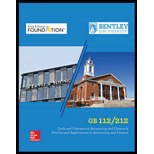
GB 112/212 MANAGERIAL ACC. W/ACCESS >C<
17th Edition
ISBN: 9781260218831
Author: Libby
Publisher: MCG CUSTOM
expand_more
expand_more
format_list_bulleted
Textbook Question
Chapter 13, Problem 1MCQ
A company has total assets of $500,000 and noncurrent assets of $400,000. Current liabilities are $40,000. What is the
- a. 12.5
- b. 10.0
- c. 2.5
- d. Cannot be determined without additional information.
Expert Solution & Answer
Want to see the full answer?
Check out a sample textbook solution
Students have asked these similar questions
Subject:- General Account
Hi teacher please help me this question solution
Calculate the cost
Chapter 13 Solutions
GB 112/212 MANAGERIAL ACC. W/ACCESS >C<
Ch. 13 - Who are the primary users of financial statements?Ch. 13 - When considering an investment in stock, investors...Ch. 13 - How does product differentiation differ from cost...Ch. 13 - What are the two general methods for making...Ch. 13 - What are component percentages? Why are they...Ch. 13 - What is ratio analysis? Why is it useful?Ch. 13 - What do profitability ratios focus on? What is an...Ch. 13 - What do turnover ratios focus on? What is an...Ch. 13 - What do liquidity ratios focus on? What is an...Ch. 13 - What do solvency ratios focus on? What is an...
Ch. 13 - What do market ratios focus on? What is an example...Ch. 13 - Prob. 12QCh. 13 - Explain why rapid growth in total sales might not...Ch. 13 - A company has total assets of 500,000 and...Ch. 13 - Prob. 2MCQCh. 13 - Prob. 3MCQCh. 13 - Prob. 4MCQCh. 13 - Prob. 5MCQCh. 13 - Prob. 6MCQCh. 13 - Prob. 7MCQCh. 13 - Prob. 8MCQCh. 13 - Prob. 9MCQCh. 13 - Prob. 10MCQCh. 13 - Prob. 13.1MECh. 13 - Prob. 13.2MECh. 13 - Prob. 13.3MECh. 13 - Computing the Financial Leverage Percentage...Ch. 13 - Analyzing the Inventory Turnover Ratio A...Ch. 13 - Prob. 13.6MECh. 13 - Prob. 13.7MECh. 13 - Prob. 13.8MECh. 13 - Prob. 13.9MECh. 13 - Prob. 13.10MECh. 13 - Using Financial Information to Identify Companies...Ch. 13 - Prob. 13.2ECh. 13 - Prob. 13.3ECh. 13 - Prob. 13.4ECh. 13 - Prob. 13.5ECh. 13 - Prob. 13.6ECh. 13 - Prob. 13.7ECh. 13 - Prob. 13.8ECh. 13 - Prob. 13.9ECh. 13 - Prob. 13.10ECh. 13 - Inferring Financial Information from Ratios E13-11...Ch. 13 - Prob. 13.12ECh. 13 - Prob. 13.13ECh. 13 - Prob. 13.1PCh. 13 - Prob. 13.2PCh. 13 - Prob. 13.3PCh. 13 - Prob. 13.4PCh. 13 - Prob. 13.5PCh. 13 - Computing Comparative Financial Statements and...Ch. 13 - Analyzing Financial Statements Using Ratios Use...Ch. 13 - Prob. 13.8PCh. 13 - Prob. 13.9PCh. 13 - Prob. 13.1APCh. 13 - Prob. 13.2APCh. 13 - Calculating Profitability, Turnover, Liquidity,...Ch. 13 - Prob. 13.4APCh. 13 - Prob. 13.5APCh. 13 - Prob. 13.6APCh. 13 - Prob. 13.1CPCh. 13 - Prob. 13.2CPCh. 13 - Comparing Companies within an Industry Refer to...Ch. 13 - Prob. 13.4CPCh. 13 - Inferring Information from the DuPont Model Ratios...Ch. 13 - Prob. 13.6CP
Knowledge Booster
Learn more about
Need a deep-dive on the concept behind this application? Look no further. Learn more about this topic, accounting and related others by exploring similar questions and additional content below.Similar questions
- The cost to manufacture an unfinished unit is $140 ($95 variable, $45 fixed). The selling price per unit is $155. The company has the unused productive capacity and has determined that units could be finished and sold for $198 with an increase in variable costs of 40%. What is the additional net income per unit to be gained by finishing the unit?arrow_forwardFinancial accounting questionarrow_forwardIf sales revenue is $110 million and accounts receivable increased by $18 million, the amount of cash received from customers: a. was $110 million. b. was $73 million. c. depends on the mix of cash sales and credit sales. d. was $92 million.arrow_forward
arrow_back_ios
SEE MORE QUESTIONS
arrow_forward_ios
Recommended textbooks for you
 Cornerstones of Financial AccountingAccountingISBN:9781337690881Author:Jay Rich, Jeff JonesPublisher:Cengage Learning
Cornerstones of Financial AccountingAccountingISBN:9781337690881Author:Jay Rich, Jeff JonesPublisher:Cengage Learning

Cornerstones of Financial Accounting
Accounting
ISBN:9781337690881
Author:Jay Rich, Jeff Jones
Publisher:Cengage Learning
Financial ratio analysis; Author: The Finance Storyteller;https://www.youtube.com/watch?v=MTq7HuvoGck;License: Standard Youtube License